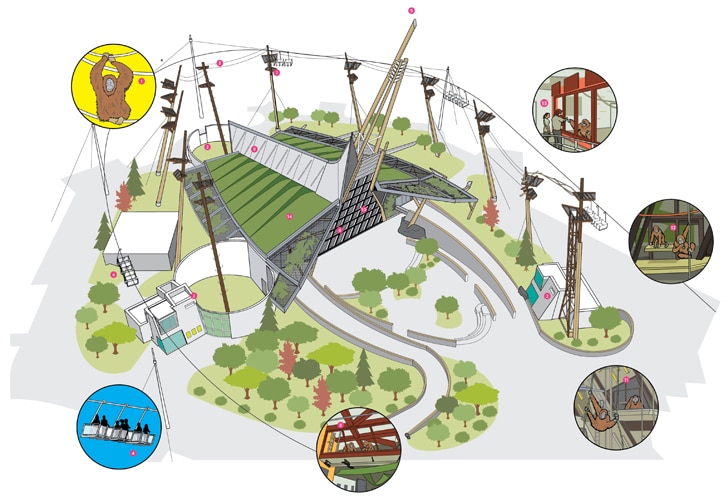
Peer Inside the Indy Zoo's New Animal House

Fire hoses acting as vines drape everywhere in the 55-foot-high main atrium, a testament to their durability. Where there are climbing bars on the wall (pretty much everywhere), the nuts and bolts had to be welded together. “Orangutans are so patient and clever,” says Rob Shumaker, Indianapolis Zoo vice president and one of the visionaries behind the Center. “They will never stop trying to disassemble their environment.”
2. QUICK GETAWAYS
Because adult male orangutans can’t stand each other, the facility had to be designed with “oases” where the guys can go to be alone. The western one has an outdoor yard, while the eastern outpost has a more elaborate tower. To the north is a yard that gives the apes access to the Hutan Trail. The yards had to be dug deeper than necessary and then backfilled with soil—you don’t want to know what an orang can do with a rock he finds in the dirt.
3. THE HIGH ROAD
The Hutan Trail stands 80 feet off the ground, and the apes can climb to it from multiple areas of the Center. Once there, they’ll use their impressive eight-foot wingspans to travel high above the facility along a cord of braided steel. Don’t worry about them falling: In the wild, they travel along shifting vegetation 150 feet in the air.

For those who can’t hang from their pinky finger, the Skyline Ride will give humans an arboreal view of the apes as they swing. Although the gondolas only move at about 2 to 3 mph, the Skyline has a faster pedigree—its maker, Chance Rides, is the engineering firm behind dozens of roller coasters.
5. BRIGHT IDEA
A 150-foot-high steeple with a light at the tip, the Beacon of Hope symbolizes the Zoo’s orangutan-conservation efforts in Sumatra and Borneo, the last places the apes exist in the wild. The orangs themselves will turn on the Beacon at night with a tablet computer in one of the oases.
6. IF IT FEELS RIGHT
Embracing the environment’s artificiality, the Zoo included no fake trees. (Orangutans quickly tear apart real ones.) Instead, Shumaker strived for what he calls “functional naturalism.” It doesn’t need to look natural. It only needs to work that way. “I’ve never met a visitor who was fooled by a concrete tree into thinking they were in Sumatra,” he says.
7. SAFETY FIRST
The orangutan’s propensity for climbing necessitates electric wire beneath the platforms to keep the animals from climbing down the poles into the Zoo’s public areas. No one wants a Jurassic Park situation.
» MORE: Meet These Eight Orangutans

In what amounts to a giant gerbil tube, the apes can travel above visitors in the Center or just people-watch.
9. LOCKDOWN
Local architecture firm Browning Day Mullins Dierdorf (IMA, Circle Centre, Speedway Pagoda) spent almost as much time designing the back-of-house cage area as it did the public areas. Using a complex system of mechanized doors, keepers hope to herd the animals toward the cages at night. “You don’t make orangutans do anything,” says lead architect Jonathan Hess. “You hope to entice them one at a time with food. But honestly, no one knows yet where they’ll choose to sleep.”
10. APE ESCAPE
To provide natural light and protect the zookeepers, architects tried to limit “blind corners”—areas where orangs might linger out of sight of a handler opening a door nearby. Although maybe not enough. Two apes briefly escaped this spring before the exhibit even opened.
11. R&R
A three-story “day room” with calming, diffused lighting offers the animals a respite from the crowds. “If you’ve had a tough day and you want to be alone,” Hess says, “this is the place.”

Lounging platforms can be found just about everywhere inside the Center, two of which invite orangs up to try interactive tasks, where they will be within inches of the public on the other side of the glass.
13) SHOWTIME
A mini theater inside the Center will occasionally showcase Shumaker engaging with an ape manipulating a touch-panel computer. He and Azy have plenty of practice—they’ve been working together for 30 years.
14) MOW? NO
The structure’s green roof consists not of grass, but of sedum, an unusual succulent that is excellent for water-gathering. “It soaks up water faster than anything else,” Hess says.
Illustrations by Colin Hayes
This article appears in the May 2014 issue.







